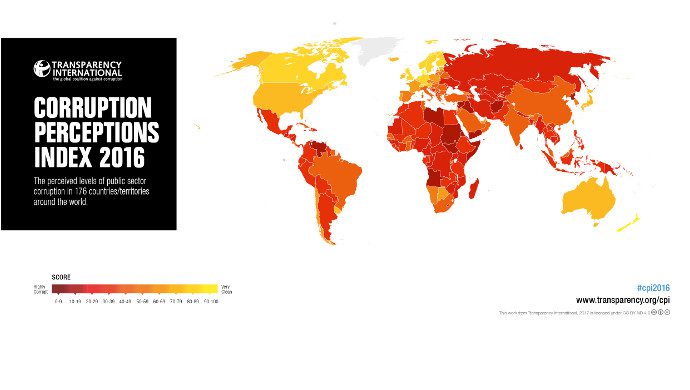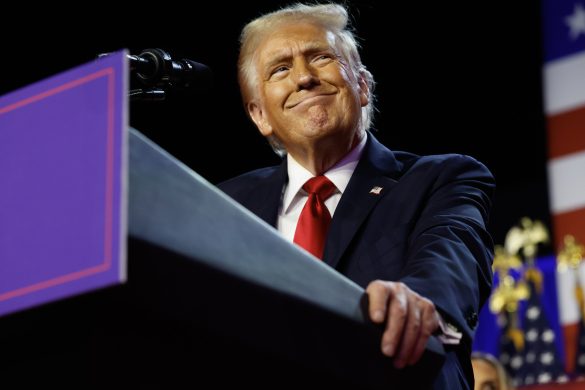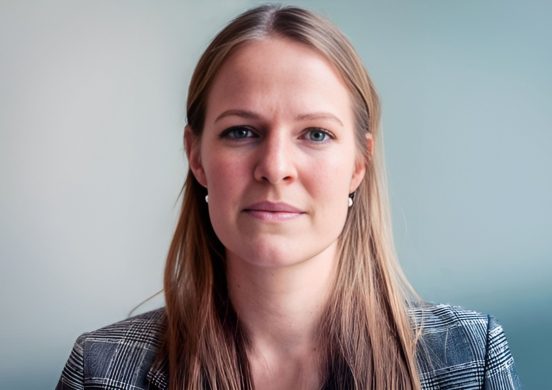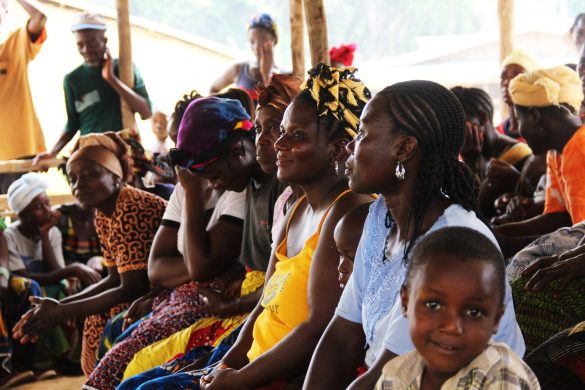Corruption Perceptions Index 2016
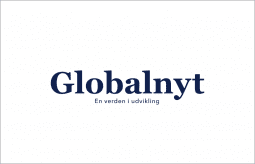
Læs meget mere og se bl.a. grafik, datasæt og metodologi på Transparency Internationals websted.
BERLIN, 25 January, 2016 (Transparency International): Let’s get straight to the point: No country gets close to a perfect score in the Corruption Perceptions Index 2016.
Over two-thirds of the 176 countries and territories in this year’s index fall below the midpoint of our scale of 0 (highly corrupt) to 100 (very clean). The global average score is a paltry 43, indicating endemic corruption in a country’s public sector. Top-scoring countries (yellow in the map below) are far outnumbered by orange and red countries where citizens face the tangible impact of corruption on a daily basis.
This year’s results highlight the connection between corruption and inequality, which feed off each other to create a vicious circle between corruption, unequal distribution of power in society, and unequal distribution of wealth.
The interplay of corruption and inequality also feeds populism. When traditional politicians fail to tackle corruption, people grow cynical. Increasingly, people are turning to populist leaders who promise to break the cycle of corruption and privilege. Yet this is likely to exacerbate – rather than resolve – the tensions that fed the populist surge in the first place. (Read more about the linkages between corruption, inequality and populism.)
More countries declined than improved in this year’s results, showing the urgent need for committed action to thwart corruption.
Putting the scores in context
The lower-ranked countries in our index are plagued by untrustworthy and badly functioning public institutions like the police and judiciary. Even where anti-corruption laws are on the books, in practice they’re often skirted or ignored. People frequently face situations of bribery and extortion, rely on basic services that have been undermined by the misappropriation of funds, and confront official indifference when seeking redress from authorities that are on the take.
Grand corruption thrives in such settings. Cases like Petrobras and Odebrecht in Brazil or the saga of ex-President Viktor Yanukovych in Ukraine show how collusion between businesses and politicians siphons off billions of dollars in revenue from national economies, benefitting the few at the expense of the many. This kind of systemic grand corruption violates human rights, prevents sustainable development and fuels social exclusion.
Higher-ranked countries tend to have higher degrees of press freedom, access to information about public expenditure, stronger standards of integrity for public officials, and independent judicial systems. But high-scoring countries can’t afford to be complacent, either. While the most obvious forms of corruption may not scar citizens’ daily lives in all these places, the higher-ranked countries are not immune to closed-door deals, conflicts of interest, illicit finance, and patchy law enforcement that can distort public policy and exacerbate corruption at home and abroad.
Regional analysis
Corruption hurts all countries, in every region of the world. Learn more about public sector corruption in your region below.
Sub Saharan Africa: 2016 saw elections across the African continent with the results providing a good reflection of corruption trends in the region. In Ghana, for example, voters voiced their dissatisfaction with the government’s corruption record at the polls where, for the first time in Ghana’s history, an incumbent president was voted out. Read more
Asia Pacific: Unfortunately, the majority of Asia Pacific countries sit in the bottom half of this year’s Corruption Perceptions Index. Poor performance can be attributed to unaccountable governments, lack of oversight, insecurity and shrinking space for civil society, pushing anti-corruption action to the margins in those countries. Read more
Middle East and North Africa: Despite the political changes that shook the Arab region six years ago, the hope for Arab countries to fight corruption and end impunity has not seen any progress yet. This explains the sharp drop of most of Arab countries on the 2016 index – 90 percent of these have scored below 50, which is a failing grade. Read more
Americas: From the Panama Papers in April to the record US$3.5 billion Odebrecht settlement in Brazil in December, 2016 was a good year in the fight against corruption in the Americas. But there is still a long way to go. Read more
Europe and Central Asia: There are no drastic changes in Europe and Central Asia on this year’s index, with only a few exceptions. However, this does not mean that the region is immune from corruption. The stagnation also does not indicate that the fight against corruption has improved, but rather the opposite. Read more

